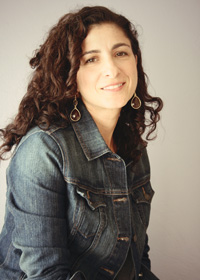 This month’s author interview is with Dev Petty, a former Visual Effects artist who “sat in a terribly dark room for ten years working as a texture painter” for films like The Matrix. Don’t read that the wrong way—she really liked it! But after having daughters, she discovered her passion and skill for writing, and things worked out for Dev there, too.
This month’s author interview is with Dev Petty, a former Visual Effects artist who “sat in a terribly dark room for ten years working as a texture painter” for films like The Matrix. Don’t read that the wrong way—she really liked it! But after having daughters, she discovered her passion and skill for writing, and things worked out for Dev there, too.
We’ll cover a lot more about her writing career below, but to prepare us for that, here are seven fun Dev facts:
- Married her high school sweetheart.
- Was on the Bay Bridge in the ’89 earthquake.
- Loves Cheezits.
- Great at word jumbles.
- Wicked good at making sandwiches.
- Swears a lot.
- Practicing Jew but devoutly Californian.
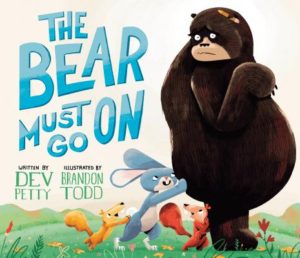 Here’s a bonus eighth thing about Dev–she’s got a new book out, The Bear Must Go On, and it looks tremendously fun.
Here’s a bonus eighth thing about Dev–she’s got a new book out, The Bear Must Go On, and it looks tremendously fun.
Plus, here are some URLs to learn a bit more about Dev and all that she does in the world of picture books:
https://nerdybookclub.wordpress.com/tag/dev-petty/
With that, let’s get right to the Qs and As here!
RVC: One thing that most text-only picture writers lament is not being able to create the art for their own books. You painted well enough to work for Hollywood. So…why aren’t you doing your own art to go with your picture book manuscripts?
DP: Yes, I was a good painter. I had a knack for color and composition and texture and was good with all the technology to make it sing. I teach art sometimes, and I make art all the time. BUT…being artistic and being able to tell a story with my art are different things. I don’t have a particular point of view. I know what I like, but that doesn’t mean I have a style and certainly no sense of character design, movement, etc. Honestly, I really like the writing part–I grew up in Berkeley in the 70s. I’m by nature pretty weird and have a lot of ideas…the writing suits me fine. Doing the art would feel sort of like a…job.
RVC: I’ll bet the Hollywood experiences still proved useful in other ways.
DP: Being in film does, for sure, inform how I tell a story. In film, you have to tell a story front to back–which is to say if someone is noticing some mistake in the background when something important is up front, you’ve failed as a storyteller. That helps me be economical with words and good at discerning what thread I want to pull on in a story.
Film also taught me to have a terribly thick skin.
RVC: What kind of writing training did you undertake when making the shift from creating art to writing picture books?
DP: I actually wasn’t much of a writer and started by taking a personal essay class, which–I ought to tell you–is the cheapest therapy you’ll ever have. I enjoyed writing but didn’t know that I wanted to write picture books until I just wrote one for fun and totally loved it. After that, I just read a lot of blog posts and a gazillion picture books and just wrote, wrote, wrote. I’m not too much for researching or classes or conferences. I just dove in and figured it out.
RVC: You’ve got a thing for animal characters, it seems. Why do they appeal to you as a storymaker?
DP: Well, yeah. I do write books with humans, just none have been picked up as yet. But I like to write about animals–they come with some intrinsic qualities that create good material. So I’m able to inject a lot into their personalities because there are already certain elements there. But I’m not one to just take a human-like character and decide it’s a walrus for the fun of it.
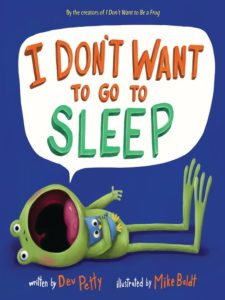 RVC: Mike Boldt—the illustrator of the Frog books—did an interview where he talked about I Don’t Want to Go to Sleep. Regarding the character of Frog, Mike said that he can “hear his voice and see his expressions just by reading the manuscript.” How do you go about creating an effective voice? What specific steps/techniques are you using?
RVC: Mike Boldt—the illustrator of the Frog books—did an interview where he talked about I Don’t Want to Go to Sleep. Regarding the character of Frog, Mike said that he can “hear his voice and see his expressions just by reading the manuscript.” How do you go about creating an effective voice? What specific steps/techniques are you using?
DP: Mike is the best–just have to get that out there!
RVC: I quite agree! (I hope he sees this and wants do his own OPB interview down the road.)
DP: Frog is fun to write because he’s sort of droll and dry but still curious and engaged in the world around him. Frog has a lot of questions. I’m not sure I take any specific steps–I can just sort of hear his voice, which is very much how I write in any case. I hear a book, at least the opening of a book, in my head before I ever put pen to paper. I don’t think I could write a narrative book with Frog. He’s all dialogue for me.
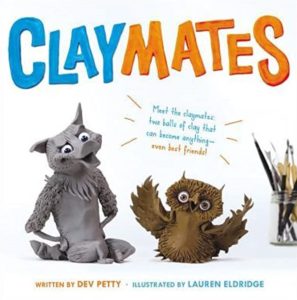 RVC: I’m a fan of Claymation, so obviously I dug your 2017 book, Claymates. What’s the story behind that book?
RVC: I’m a fan of Claymation, so obviously I dug your 2017 book, Claymates. What’s the story behind that book?
DP: A lot of wine.
Kidding!
Well, the extraordinary Lauren Eldridge and I were sort of Twitter friends and talked about working together. She would make these funny clay characters and I thought they were really hilarious. I didn’t want to take something normal, like a regular story, and have her illustrate it in clay. I wanted a story that was ABOUT the fact they were clay, where your character could be anything at any time. That’s so open and abstract and kind of 70s trippy and it all just came out at once–the ideas at least.
I pitched her the idea and she liked it! We did a full photographic dummy to try to sell it because, honestly, how could you pitch that story and not sound like a lunatic?! What’s funny is that in the same way the balls of clay become friends through experimentation, play, being silly–so did we. She’s one of my best friends in the world. Art brings the strangest bedfellows together.
RVC: You’ve talked before about the challenge of finding each story’s thread. Would you explain that concept by way via the creation of one of your books?
DP: Well, Claymates is actually a great example. On the one hand, it’s just some goofball book about some balls of clay who make a mess of themselves. But in a bigger way, the thread of Claymates is about how no matter how many and what sort of hands (parents, teachers, friends) are trying to mold and shape us at any given time, ultimately we have an insatiable need to evolve on our own, experiment, make mistakes, play. I try to remember this as a parent–not to tinker too much in who my kids will become, they have to shape themselves. As long as they’re happy and good people, I don’t care what they end up doing.
RVC: In a 2014 guest post on Tara Lazar’s fine blog, you recommend writers stop writing. Care to give us an explanation on that surprising idea?
DP: Well, I think it’s really easy to go too quickly to writing once you have an idea. You get this lightbulb and want to RUN to start writing. But I’ve found I do much better when I just let things percolate a while, otherwise I just end up shuffling words about on the page instead of digging a little deeper, trying things, finding the thread.
RVC: While OPB interviews agents, we don’t always talk about the HOWS and WHYS of having/getting one. You’re with Jennifer Rofé at the Andrea Brown Literary Agency, right? How did you land that relationship, and what has it done for your career?
DP: Jen is actually my third agent (loooooonnnnnng story) and I’m so grateful I reached out to her when I was again looking. She’s Mike Boldt’s agent too, so I already knew she was awesome. Jen pushes me, sometimes really hard, to do my best work. She’s editorial, honest, and whipsmart. I rarely feel intimidated by anyone but if I were to, it might be her. Not because she’s mean, because she’s just really sharp, engaged, and articulate. When we talk I write “don’t babble” on my hands because she is so on point with everything and I never want to look back and think, “Darn, Dev, you babbled!”
But she’s also kind and has an uncanny sense of the industry and how to balance life and writing. She’s just a fantastic person and I’m very lucky.
RVC: If you could time-travel back to that first year of your writing apprenticeship, what would you tell yourself to ease the process? What do you know now that you wish you knew then?
DP: I suppose that it’s just a really slow process, even if you start out with a popular book like I did. It takes time to build this career and you don’t want to rush it just to sell books. I learned most of that from Jen, for what it’s worth.
RVC: Alright, it’s time to transition to the always-fun, never-equaled, ever-exciting SPEED ROUND! Are you ready?
DP: Word.
RVC: The Carlton Dance, the Macarena, or the Cha Cha Slide. Which are we most likely to catch you performing?
DP: The Macarena. (I don’t even know what the other two are, but I still know without doubt the answer is the Macarena!)
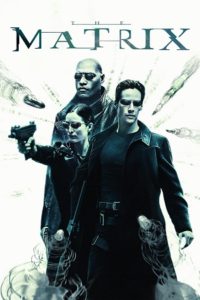 RVC: Most underappreciated film in The Matrix series?
RVC: Most underappreciated film in The Matrix series?
DP: The first one. Everyone loves it and appreciates it and knows it’s the best and it still couldn’t be overappreciated because it’s really original and thoughtful and smart, so it’s probably underappreciated.
RVC: If picture books were ice cream flavors, what flavor would your Frog series be?
DP: Bubblegum. It’s hard to know what the underlying flavor is and there’s weird chewy bits inside for some reason that you pick out and let stain and stick to your napkin and then eat all at once for like five minutes before spitting it out.
RVC: What’s something about your writing process that might surprise people?
DP: I tend to write the opening a bunch of different ways before committing. Once I find one I like, I let that guide the rest of the writing. I throw a LOT away but save everything in case I did something great.
RVC: “The last truly GREAT picture book I read was __________.”
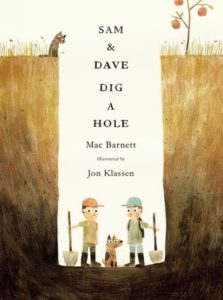 DP: Oooh. I’m really picky actually. In a way that probably doesn’t serve me well. Sam & Dave Dig a Hole is up there, for sure. It’s dead smart.
DP: Oooh. I’m really picky actually. In a way that probably doesn’t serve me well. Sam & Dave Dig a Hole is up there, for sure. It’s dead smart.
RVC: The one-sentence message you hope all of your picture books deliver?
DP: Ask questions.
RVC: Thanks so much, Dev!
DP: The pleasure is mine! Thank you!

